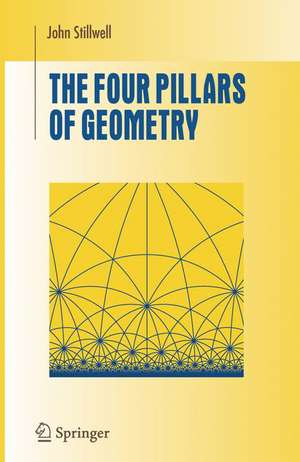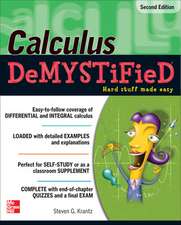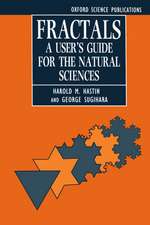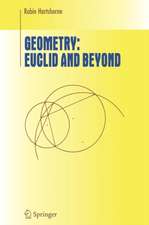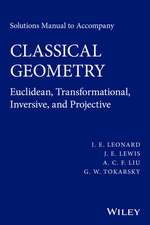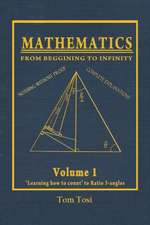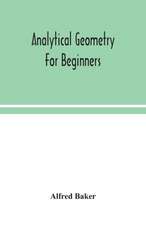The Four Pillars of Geometry: Undergraduate Texts in Mathematics
Autor John Stillwellen Limba Engleză Hardback – 9 aug 2005
| Toate formatele și edițiile | Preț | Express |
|---|---|---|
| Paperback (1) | 280.65 lei 3-5 săpt. | +20.41 lei 4-10 zile |
| Springer – dec 2010 | 280.65 lei 3-5 săpt. | +20.41 lei 4-10 zile |
| Hardback (1) | 392.32 lei 3-5 săpt. | |
| Springer – 9 aug 2005 | 392.32 lei 3-5 săpt. |
Din seria Undergraduate Texts in Mathematics
- 17%
 Preț: 362.13 lei
Preț: 362.13 lei - 17%
 Preț: 365.43 lei
Preț: 365.43 lei - 20%
 Preț: 466.84 lei
Preț: 466.84 lei - 17%
 Preț: 367.24 lei
Preț: 367.24 lei -
 Preț: 351.54 lei
Preț: 351.54 lei -
 Preț: 395.09 lei
Preț: 395.09 lei - 8%
 Preț: 384.89 lei
Preț: 384.89 lei -
 Preț: 306.96 lei
Preț: 306.96 lei -
 Preț: 380.27 lei
Preț: 380.27 lei -
 Preț: 400.43 lei
Preț: 400.43 lei -
 Preț: 358.11 lei
Preț: 358.11 lei -
 Preț: 372.27 lei
Preț: 372.27 lei -
 Preț: 400.43 lei
Preț: 400.43 lei -
 Preț: 364.41 lei
Preț: 364.41 lei - 17%
 Preț: 368.61 lei
Preț: 368.61 lei -
 Preț: 433.85 lei
Preț: 433.85 lei -
 Preț: 304.91 lei
Preț: 304.91 lei -
 Preț: 290.80 lei
Preț: 290.80 lei - 13%
 Preț: 389.61 lei
Preț: 389.61 lei - 17%
 Preț: 395.93 lei
Preț: 395.93 lei -
 Preț: 407.96 lei
Preț: 407.96 lei -
 Preț: 449.62 lei
Preț: 449.62 lei -
 Preț: 415.95 lei
Preț: 415.95 lei -
 Preț: 280.65 lei
Preț: 280.65 lei -
 Preț: 370.78 lei
Preț: 370.78 lei -
 Preț: 407.63 lei
Preț: 407.63 lei -
 Preț: 339.37 lei
Preț: 339.37 lei -
 Preț: 402.35 lei
Preț: 402.35 lei - 17%
 Preț: 373.60 lei
Preț: 373.60 lei -
 Preț: 398.78 lei
Preț: 398.78 lei -
 Preț: 440.01 lei
Preț: 440.01 lei -
 Preț: 424.14 lei
Preț: 424.14 lei - 17%
 Preț: 366.38 lei
Preț: 366.38 lei -
 Preț: 367.41 lei
Preț: 367.41 lei -
 Preț: 257.71 lei
Preț: 257.71 lei - 17%
 Preț: 362.67 lei
Preț: 362.67 lei - 15%
 Preț: 417.75 lei
Preț: 417.75 lei - 17%
 Preț: 366.40 lei
Preț: 366.40 lei - 19%
 Preț: 400.52 lei
Preț: 400.52 lei -
 Preț: 298.01 lei
Preț: 298.01 lei -
 Preț: 329.95 lei
Preț: 329.95 lei - 19%
 Preț: 492.83 lei
Preț: 492.83 lei -
 Preț: 396.24 lei
Preț: 396.24 lei -
 Preț: 390.08 lei
Preț: 390.08 lei
Preț: 392.32 lei
Nou
Puncte Express: 588
Preț estimativ în valută:
75.08€ • 81.53$ • 63.07£
75.08€ • 81.53$ • 63.07£
Carte disponibilă
Livrare economică 01-15 aprilie
Preluare comenzi: 021 569.72.76
Specificații
ISBN-13: 9780387255309
ISBN-10: 0387255303
Pagini: 244
Ilustrații: XI, 229 p.
Dimensiuni: 155 x 235 x 19 mm
Greutate: 0.52 kg
Ediția:2005
Editura: Springer
Colecția Springer
Seria Undergraduate Texts in Mathematics
Locul publicării:New York, NY, United States
ISBN-10: 0387255303
Pagini: 244
Ilustrații: XI, 229 p.
Dimensiuni: 155 x 235 x 19 mm
Greutate: 0.52 kg
Ediția:2005
Editura: Springer
Colecția Springer
Seria Undergraduate Texts in Mathematics
Locul publicării:New York, NY, United States
Public țintă
Lower undergraduateCuprins
Straightedge and compass.- Euclid’s approach to geometry.- Coordinates.- Vectors and Euclidean spaces.- Perspective.- Projective planes.- Transformations.- Non-Euclidean geometry.
Recenzii
From the reviews:
"This is an introductory book on geometry, easy to read, written in an engaging style. The author’s goal is … to increase one’s overall understanding and appreciation of the subject. … Along the way, he presents elegant proofs of well-known theorems … . The advantage of the author’s approach is clear: in a short space he gives a brief introduction to many sides of geometry and includes many beautiful results, each explained from a perspective that makes it easy to understand." (Robin Hartshorne, SIAM Review, Vol. 48 (2), 2006)
"The pillars of the title are … Euclidean construction and axioms, coordinates and vectors, projective geometry, and transformations and non-Euclidean geometry. … The writing style is both student-friendly and deeply informed. The pleasing brevity of the book … makes the book especially suitable as an instruction to geometry for the large and critically important population of undergraduate mathematics majors … . Each chapter concludes with a well-written discussion section that combines history with glances at further results. There is a good selection of thought-provoking exercises." (R. J. Bumcrot, Mathematical Reviews, Issue 2006 e)
"The author acts on the assumption of four approaches to geometry: The axiomatic way, using linear Algebra, projective geometry and transformation groups. … Each of the chapters closes with a discussion giving hints on further aspects and historical remarks. … The book can be recommended to be used in undergraduate courses on geometry … ." (F. Manhart, Internationale Mathematische Nachrichten, Issue 203, 2006)
"Any new mathematics textbook by John Stillwell is worth a serious look. Stillwell is the prolific author of more than half a dozen textbooks … . I would not hesitate to recommend this text to any professor teaching a course in geometry who is more interested in providing a rapid survey of topics rather than an in-depth,semester-long, examination of any particular one." (Mark Hunacek, The Mathematical Gazette, Vol. 91 (521), 2007)
"The title refers to four different approaches to elementary geometry which according to the author only together show this field in all its splendor: via straightedge and compass constructions, linear algebra, projective geometry and transformation groups. … the book can be recommended warmly to undergraduates to get in touch with geometric thinking." (G. Kowol, Monatshefte für Mathematik, Vol. 150 (3), 2007)
"This book presents a tour on various approaches to a notion of geometry and the relationship between these approaches. … The book shows clearly how useful it is to use various tools in a description of basic geometrical questions to find the simplest and the most intuitive arguments for different problems. The book is a very useful source of ideas for high school teachers." (EMS Newsletter, March, 2007)
“The four pillars of geometry approaches geometry in four different ways, devoting two chapters to each, the first chapter being concrete and introductory, the second more abstract. … The content is quite elementary and is based on lectures given by the author at the University of San Francisco in 2004. … The book of Stillwell is a very good first introduction to geometry especially for the axiomatic and the projective point of view.” (Yves Félix, Bulletin of the Belgian Mathematical Society, Vol. 15 (1), 2008)
"This is an introductory book on geometry, easy to read, written in an engaging style. The author’s goal is … to increase one’s overall understanding and appreciation of the subject. … Along the way, he presents elegant proofs of well-known theorems … . The advantage of the author’s approach is clear: in a short space he gives a brief introduction to many sides of geometry and includes many beautiful results, each explained from a perspective that makes it easy to understand." (Robin Hartshorne, SIAM Review, Vol. 48 (2), 2006)
"The pillars of the title are … Euclidean construction and axioms, coordinates and vectors, projective geometry, and transformations and non-Euclidean geometry. … The writing style is both student-friendly and deeply informed. The pleasing brevity of the book … makes the book especially suitable as an instruction to geometry for the large and critically important population of undergraduate mathematics majors … . Each chapter concludes with a well-written discussion section that combines history with glances at further results. There is a good selection of thought-provoking exercises." (R. J. Bumcrot, Mathematical Reviews, Issue 2006 e)
"The author acts on the assumption of four approaches to geometry: The axiomatic way, using linear Algebra, projective geometry and transformation groups. … Each of the chapters closes with a discussion giving hints on further aspects and historical remarks. … The book can be recommended to be used in undergraduate courses on geometry … ." (F. Manhart, Internationale Mathematische Nachrichten, Issue 203, 2006)
"Any new mathematics textbook by John Stillwell is worth a serious look. Stillwell is the prolific author of more than half a dozen textbooks … . I would not hesitate to recommend this text to any professor teaching a course in geometry who is more interested in providing a rapid survey of topics rather than an in-depth,semester-long, examination of any particular one." (Mark Hunacek, The Mathematical Gazette, Vol. 91 (521), 2007)
"The title refers to four different approaches to elementary geometry which according to the author only together show this field in all its splendor: via straightedge and compass constructions, linear algebra, projective geometry and transformation groups. … the book can be recommended warmly to undergraduates to get in touch with geometric thinking." (G. Kowol, Monatshefte für Mathematik, Vol. 150 (3), 2007)
"This book presents a tour on various approaches to a notion of geometry and the relationship between these approaches. … The book shows clearly how useful it is to use various tools in a description of basic geometrical questions to find the simplest and the most intuitive arguments for different problems. The book is a very useful source of ideas for high school teachers." (EMS Newsletter, March, 2007)
“The four pillars of geometry approaches geometry in four different ways, devoting two chapters to each, the first chapter being concrete and introductory, the second more abstract. … The content is quite elementary and is based on lectures given by the author at the University of San Francisco in 2004. … The book of Stillwell is a very good first introduction to geometry especially for the axiomatic and the projective point of view.” (Yves Félix, Bulletin of the Belgian Mathematical Society, Vol. 15 (1), 2008)
Textul de pe ultima copertă
For two millennia the right way to teach geometry was the Euclidean approach, and in many respects, this is still the case. But in the 1950s the cry "Down with triangles!" was heard in France and new geometry books appeared, packed with linear algebra but with no diagrams. Was this the new right approach? Or was the right approach still something else, perhaps transformation groups?
The Four Pillars of Geometry approaches geometry in four different ways, spending two chapters on each. This makes the subject accessible to readers of all mathematical tastes, from the visual to the algebraic. Not only does each approach offer a different view; the combination of viewpoints yields insights not available in most books at this level. For example, it is shown how algebra emerges from projective geometry, and how the hyperbolic plane emerges from the real projective line.
The author begins with Euclid-style construction and axiomatics, then proceeds to linear algebra when it becomes convenient to replace tortuous arguments with simple calculations. Next, he uses projective geometry to explain why objects look the way they do, as well as to explain why geometry is entangled with algebra. And lastly, the author introduces transformation groups---not only to clarify the differences between geometries, but also to exhibit geometries that are unexpectedly the same.
All readers are sure to find something new in this attractive text, which is abundantly supplemented with figures and exercises. This book will be useful for an undergraduate geometry course, a capstone course, or a course aimed at future high school teachers.
John Stillwell is Professor of Mathematics at the University of San Francisco. He is the author of several highly regarded books published by Springer, including Elements of Number Theory (2003), Mathematics and Its History (Second Edition, 2002), Numbers and Geometry (1998) and Elements of Algebra (1994).
The Four Pillars of Geometry approaches geometry in four different ways, spending two chapters on each. This makes the subject accessible to readers of all mathematical tastes, from the visual to the algebraic. Not only does each approach offer a different view; the combination of viewpoints yields insights not available in most books at this level. For example, it is shown how algebra emerges from projective geometry, and how the hyperbolic plane emerges from the real projective line.
The author begins with Euclid-style construction and axiomatics, then proceeds to linear algebra when it becomes convenient to replace tortuous arguments with simple calculations. Next, he uses projective geometry to explain why objects look the way they do, as well as to explain why geometry is entangled with algebra. And lastly, the author introduces transformation groups---not only to clarify the differences between geometries, but also to exhibit geometries that are unexpectedly the same.
All readers are sure to find something new in this attractive text, which is abundantly supplemented with figures and exercises. This book will be useful for an undergraduate geometry course, a capstone course, or a course aimed at future high school teachers.
John Stillwell is Professor of Mathematics at the University of San Francisco. He is the author of several highly regarded books published by Springer, including Elements of Number Theory (2003), Mathematics and Its History (Second Edition, 2002), Numbers and Geometry (1998) and Elements of Algebra (1994).
Caracteristici
This book is unique in that it looks at geometry from 4 different viewpoints - Euclid-style axioms, linear algebra, projective geometry, and groups and their invariants Approach makes the subject accessible to readers of all mathematical tastes, from the visual to the algebraic Abundantly supplemented with figures and exercises Includes supplementary material: sn.pub/extras
